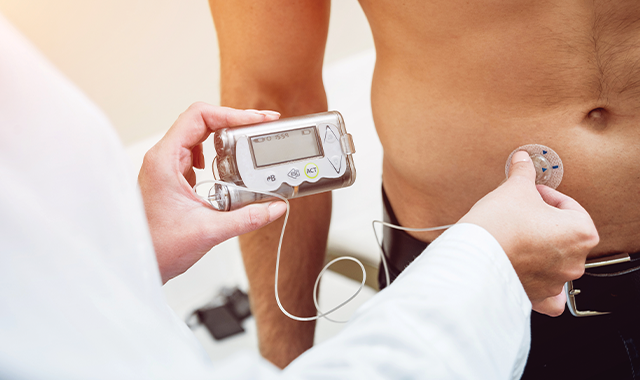21st Century-Style Diabetes Disease Management: Coaches and Tech-Enabled
Several Blues plans have contracted with vendors that supply tech-enabled diabetes disease management and prevention programs. Sometimes the tech is combined with coaching - by a real, live human being.

To help its members prevent or manage diabetes, Blue Cross and Blue Shield of Minnesota opted for a virtual solution.
The Minnesota health insurer has partnered with Omada Health, based in San Francisco, to offer technology-enabled disease education and management programs to its members with diabetes or prediabetes. Omada Health has separate programs for each disease that are based on nationally recognized training and education programs.
The Omada programs feature live coaches who help patients improve their biometric data, such as weight or A1C levels. Using data analytics to parse data collected through connected devices, including scales and glucose monitors, Omada Health derives a personalized program for each participant. Using a digital app on their smartphones, members connect with their coaches through texting or virtual visits.
The intimacy of a personal coach and the convenience of virtual care appeal to Blue Cross members, explains Jen Benner, clinical product manager at the Minnesota Blues plan, whose parent company has invested in Omada. The pairing of a coach and a virtual care is especially important for individuals with diabetes, she adds “because they have so many decisions to make every day.”
Related: What Will Be the Most Costly Medical Conditions In 10 Years?
Omada Health is not alone in selling technology-enabled programs to help peopleprevent or manage diabetes. These programs are moving quickly from being novelty items for early adopters into mainstream use. The move from the fringe is something to encourage, says Michael Sturmer, senior vice president of health services for Livongo, a publicly traded disease management company in Mountain View, California.
“What we are really focused on with our health plan partners and our PBMs is really changing their mindset from digital health as this add-on or buy-up to digital health as part of the core benefits that a member expects to get when they sign up for their health plan,” says Sturmer.
Virtual, tech-enabled programs for diabetes are catching on for any number of reasons. First, there is prevalence of diabetes and the associated expense. The American Diabetes Association says about 30 million Americans have diabetes and estimated that in 2017, an American diagnosed with the disease incurred, on average, $16,750 per year in medical expenses. Second, the programs seem to be producing promising results. Independent studies are few and far between, but the vendors have released their own study results showing weight loss and improved A1C levels.
Virta Health, a San Francisco company that says its goal is not just to manage type 2 diabetes but reverse it, uses technology to help participants limit carbohydrate intake. The company released results that it claims show that its technology reversed type 2 diabetes in 60% of its patients. This means the patients’ blood glucose readings are in a normal range, without diabetic-specific medications. For some of its earliest patients, those results have been sustained for four years, according to CEO and co-founder Sami Inkinen.
Meaningful weight loss
Blue Cross and Blue Shield of Minnesota began using Omada’s diabetes-prevention program in 2015. The program for individuals with full-blown type 2 diabetes was adopted in 2019.
The prevention program includes intensive coaching for weight loss, goal setting, and an online peer-support group. It is designed to last 16 weeks, but members can remain engaged in the program for as long as they wish, say Benner, the Minnesota Blues clinical products manager. Participants also get a wireless digital scale that sends weight readings to Omada’s database.
Benner says the cellular feature of the scale is important because not all consumers have internet access at home. Since 2015, 37,000 members of Blue Cross and Blue Shield of Minnesota have enrolled in the virtual program and lost a combined 200,000 pounds, an average of 5.4 pounds per person.
Intermountain Healthcare, which also has invested in Omada Health, has seen similar results. The Salt Lake City health system began offering Omada’s diabetes prevention program to its employees in 2019. From January 1 through November 30, 2019, 1,533 Intermountain employees lost a total of 9,800 pounds, an average of 6.4 pounds per person.
“A 5% weight loss is associated with a nearly 60% reduced risk in developing type 2 diabetes. A 10% weight loss from baseline - 20 pounds for a 200-pound person - is associated with an 85% reduction in the likelihood of developing type 2 diabetes,” says Elizabeth Joy, MD, senior medical director for wellness and nutrition at Intermountain. However, she was referencing research findings for in-person diabetes prevention programs, not tech-enabled plans like Omada’s.
“Type 2 diabetes is largely preventable for the vast majority of people by making lifestyle changes that result in relatively minimal weight loss,” Joy continues. “That is a really important point to make, because we get saturated with TV shows like ‘The Biggest Loser’ that basically say the only weight loss that is meaningful is a 50- to 100-pound weight loss. Clinically meaningful weight loss is 3% to 5% from baseline.”
The potential market for tech-enabled diabetes management could be gigantic because of the number of people with diabetes and relative lack of alternative offerings. In a 2014 study, for example, the CDC found that only 6.8% of commercially insured, newly diagnosed patients received formal diabetes education.
Blue Cross and Blue Shield of Kansas City offers its members access to a diabetes management program from Livongo. The insurer, known as Blue KC, launched a pilot program in 2016 and made the Livongo program available to all of its members during the fourth quarter of 2019. As of January 2020, Blue KC had enrolled 1,237 members in Livongo’s diabetes management program, according to Tim O’Brien, vice president and executive director of care delivery at Blue KC.
Blue KC plans to integrate patient data generated by Livongo’s platform into the electronic health records at Spira Care, which is Blue KC’s combined health insurance and primary care plan. Spira’s seven care centers provide members with access to primary care and behavioral health providers, health coaches, generic prescriptions, laboratory services, and digital X-rays.
Livongo says its customers, which include self-insured employers as well as health plans, yield savings. For example, Livongo compared health claims data for 3,664 participants in its diabetes management program with data from 12,065 people with diabetes who were not enrolled in Livongo’s program. Livongo found that participants in its diabetes management program netted a mean reduction of A1C ranging from 7.8% to 6.9% and a 5.8% decrease in the cost of healthcare claims.
Some of the tech-enabled programs offer value-based pricing. Virta bases its charges on clinical outcomes. “If we hit certain thresholds, we get paid, and if not, we don’t get paid,” says Inkinen. The metrics Virta uses are improvements in blood sugar control, reductions in medications, and weight loss. The company bills customers monthly for patient cases meeting specified thresholds.
“To me, that is how healthcare should be,” says Inkinen. “We shouldn’t be here to do more transactions. We should be here to make the patients better.”
Linda Wilson is an experienced writer and editor specializing in the healthcare industry.

In the Scope of Virtual Health and the Future of “Website” Manner, Per Ateev Mehrotra
August 10th 2023Briana Contreras, an editor of Managed Healthcare Executive, had the pleasure of catching up with MHE Editorial Advisory Board Member, Ateev Mehrotra, MD, MPH, who is a professor of healthcare policy at Harvard Medical School and an Associate Professor of Medicine and Hospitalist at Beth Israel Deaconess Medical Center.
Listen